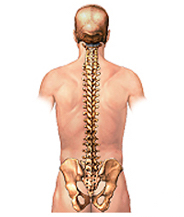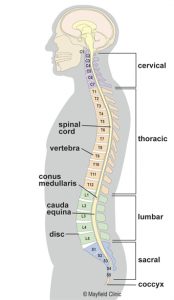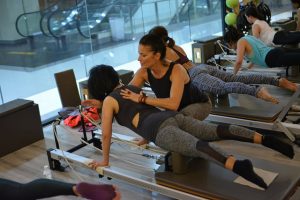Hello Everyone,
Hope you’re having a Pil-easant Week!
When you join my Certifications and Pilates classes, you will notice my emphasis on the impact Pilates exercises have on your Spine. Therefore, words like ‘mobilize’ and ‘stabilize’ the spine are common phrases you will hear me use. The Spine is such a crucial part of the body which is why education about the importance of keeping it healthy is a must during my Certifications and Classes.
Why a Healthy Spine?
Your ability to sleep, walk, move and function normally has a lot to do with the Spine which is why it is the foundation of the Human Body and is so important to maintain in order to lead a healthy life. The condition of our spine depends on our lifestyle and how we manage our posture as well as our body movements. When the spine suffers an imbalance of some sort, things start getting difficult; and in some cases, painful! Such imbalances could include injury, strain or even diseases.
Even simple daily movements such as bending down, picking up something, walking, flexing, moving become such a daunting task if unhealthy or poorly maintained. Mobility becomes an issue and walking with pain becomes part of life which destroys the ‘happiness’ of life.
Basic Anatomy of our Spine
Our Spine is made up of a structure of 33 bones that are stacked on top of one another and this is called the Vertebrae. This forms a Spinal column which facilitates the body to stand upright, twist, bend, stretch while protecting the spinal cord (which are the nerve roots inside the column) from any damages or injuries.
The Spinal cord allows for the communication between the body and the brain to allow physical functionality to take place. If the spinal cord gets injured, the information exchange between the brain and other parts of the body become disorientated.
The Spinal column is your main support for the body and can be divided into the following sections:
- Cervical (neck)– this part of the spinal column supports the weight of the head. The vertebrae of this area allows for different range of motion which is why you are able to nod a ‘yes’ or a ‘no’
- Thoracic (mid-back)– this part of the spinal column allows you to support your rib cage and protect the lungs and heart. The range of motion is very limited.
- Lumbar (lower back)– this part of the spinal column allows you to support the weight of the body. The range of motion expands to allow you to endure the stress of lifting and carrying heavy items which is why it is large in size.
- Sacrum/Sacral– this part of the spinal column allows you to link the spine to the hip bones and the vertebrae of this are merged together to form the pelvic region. The range of motion in this area encourages walking, standing and maintaining stability of the hip.
- Coccyx – this part of the spinal column attaches the ligaments and muscles of the pelvic area and is sometimes known as the tailbone. The range of motion in this area helps support the weight of the body while sitting.
The natural curves of the spine are supported by the back (extensors) and abdominal (flexor) muscles. The extensor muscles allow us to lift objects and stand up while balancing the body. The flexor muscles are placed at the front to allow us to bend forward as well as control the curvature of the lower back.
It is vital to maintain a good posture by training the body to walk, stand, sit and lie down so that the least amount of pressure is placed on the spine during any kind of movement or physical activity. Besides the physical movement or activity; posture, weak muscles and excess weight have a major impact on the spine’s alignment. A lot of misalignments happen because of not knowing how to manage the posture.
Pilates for the Spine
Pilates has become a trending exercise program for addressing spine conditions as recommended by several healthcare professionals worldwide. Not only that, it is also becoming more recognized for preventing spinal conditions that could occur in the future.
- Pilates exercises promote further strength and flexibility of the spine’s mobility and range of motion;
- Pilates exercises focus on the individual’s posture by correcting it as well as ensuring appropriate alignment of the spine;
- Pilates exercises activate the core and pelvic stabilizers which strengthens the muscles that support the spine and prevents it from injuries due to poor posture, inactivity or inappropriate body movements;
- Pilates exercises touch upon hard-to-target deeper muscles which is why weaker muscles are addressed and further strengthened;
- Pilates exercises involve controlled breathing techniques which help direct and penetrate clean air to the lower part of the lungs which makes the exchange of oxygen far more efficient. Greater oxygen supports mobility of the thoracic part of the spine and the spinal cord gets more oxygenated which improves the functions of the body;
- Pilates exercises involve a tremendous amount of focus between the mind and the body. For each exercise, instructors focus on how to correctly position the spine along with breathing, posture and coordination of movement of the arms and legs. This eventually enhances the body’s strength and overall physical mobility;
- Pilates exercises done regularly and completed over a period of time helps address weight issues which improves the condition of the spine due to a better posture.
I can go on and on and on when it comes to the Spine as this is such an important part for me when I teach Pilates. When I explain about the Spine, I do it with Precision, Skill and Care, the motto of our Swiss Pilates Institute. In my Certifications, I provide an in-depth understanding of the Spine by further explaining anatomy as well as how Pilates exercises are applied to ensure proper alignment and management of the spine.
To Join my Pilates Certifications, please click here for more info: https://sanamotion.com/swisspilates/
With Love, Patricia



